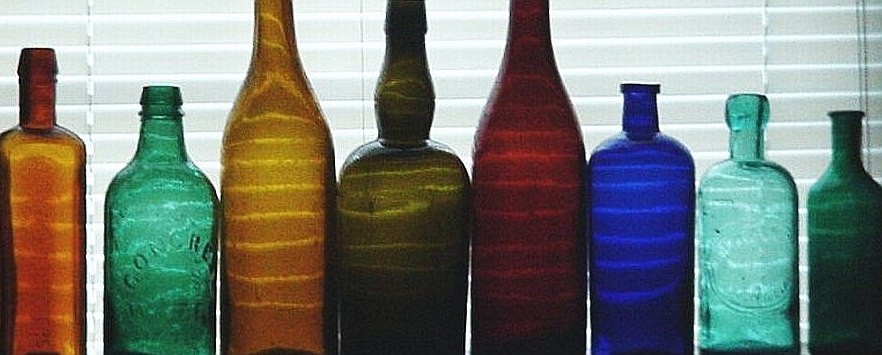St. Louis, Missouri (1882 – 1898)
A search (by the author of this site) of St. Louis city directories in March of 2005 revealed that the relatively obscure plant known as the Frederick Heitz Glass Works operated in that city for approximately 16 years. Frederick Heitz’s factory was located on the north side of Dorcas Street, between First and Koskiusco Streets.
According to a brief mention in the trade magazine Engineering and Building Record & Sanitary Engineer, Vol. 5, page 504 (May 11, 1882), the glass factory was built (either having recently finished construction, or still under construction at that time – this is unclear) at a cost of $40,800. Owner: Fred. Heitz.
Most commonly, the F.H.G.W. mark is seen on the bottoms of export-style pint and quart-size beer bottles, as well as on “wax sealer” type fruit jars, both of which have an unmistakably characteristic American “look” about them. These wax sealers are virtually identical in appearance to typical specimens made by factories in the American Midwest during the 1880s, especially at St. Louis, Missouri; Louisville, Kentucky; Pittsburgh, Pennsylvania, and at several glass plants in the state of Indiana.
These marks were incorrectly attributed to the Frederick Hampson Glass Works, Salford, Lancashire, England, by author/researcher Julian Toulouse in Bottle Makers and their Marks (1971), page 202.

Alice Creswick, in her exhaustive reference The Fruit Jar Works, illustrates wax sealer jars base-lettered “F.H.” and “F.H.G.W.”, with various mold numbers centered below the initials (similar to the way in which the bottles are marked) and she attributed both markings to the Federal Hill Glass Works (also known as the Baltimore Glass Works), Baltimore, Maryland. However, there is no evidence that Federal Hill ever marked any items with these initials. Furthermore, Federal Hill Glass Works did not operate past 1870 (or 1873, according to one source), which was too early for the manufacture of the type of export beer bottles which carry the FHGW marking. (See accompanying pic of typical “export beer” bottle — this picture is from a page on Bill Lindsey’s extensive website on antique bottles located here: Beer Bottle Shapes).

This type of bottle was not manufactured until approximately 1876, after Anheuser-Busch of St. Louis began the pasteurizing of beer which permitted it to be bottled and exported in large quantities throughout the U.S., and especially throughout the West. Many other breweries in St. Louis marketed competing brands that were packaged in these typically shaped “generic” beer bottles — many of which were made by several glass plants located in St. Louis and the surrounding area.
Other bottle manufacturers that made similar “export beer” style bottles include Lindell Glass Company (see L.G.Co. mark); Mississippi Glass Company (M. G. Co. mark) ; Hemingray Glass Company (H. G. CO.); as well as Adolphus Busch Glass Manufacturing Company (A.B.G.M.Co.) ; Illinois Glass Company, Alton, Illinois (I G Co); Streator Bottle and Glass Company, of Streator, Illinois (S B & G CO) ; Kentucky Glass Works Company (K.Y.G.W.) ; Falls City Glass Company (F.C.G.CO.); Reed & Company (R & Co) and a number of other bottle makers, most located in the Midwestern states.
Typically, but not always, the glassworks initials are accompanied by a mold identification or “shop” number on the base of the container. As seen on the photos here, examples include “4” and “5” shop or mold numbers situated underneath the initials. FHGW beer bottles have been found marked with mold numbers ranging anywhere between 1 and 89!
Drawings of some base markings can be seen illustrated in Bottles on the Western Frontier by Rex L. Wilson (1981, University of Arizona Press), page 115-117. Those drawings represent actual bases (either shards or whole bottles) found at Fort Union, New Mexico during an archaeological excavation, and the bottles all dated sometime between 1863 and 1891.
ADVERTISEMENT
Besides the fruit jars and beer bottles, some local soda bottles are found with an “F.H.” mark, including one marked “SPANNAGEL S & M W Co / S / EAST ST LOUIS / ILLS”. On this example, the “F H” mark is rather faint, and located on the lower heel area opposite the primary marking.
More information on the Frederick Heitz and the FHGW mark can be found in this article written by Bill Lockhart:
https://sha.org/bottle/pdffiles/BLockhart_FHGW.pdf .
NOTE: Here’s an updated, expanded article (containing info from above article) but with additional background information on the FHGW factory…. New and interesting information was provided to Bill Lockhart by Terry Schaub. https://sha.org/bottle/pdffiles/FHGW.pdf





Glass Manufacturers’ Marks on Bottles, Fruit Jars, Insulators and Tableware.
Please click here to go to my site Home Page.
Click here to check out my webpage on Numbers seen on the bottoms of Glass Bottles and Jars.
ADVERTISEMENT


